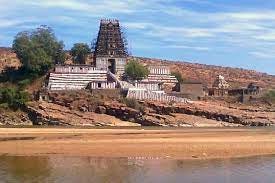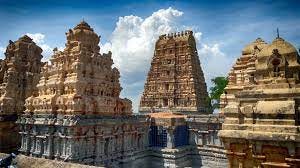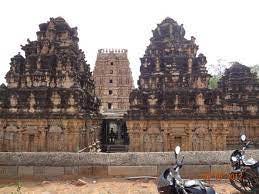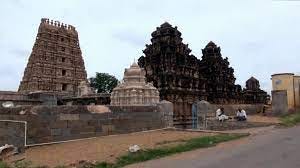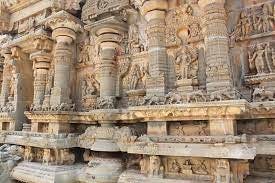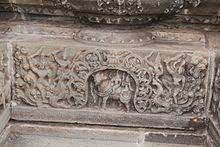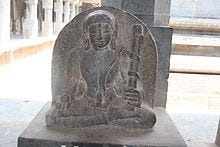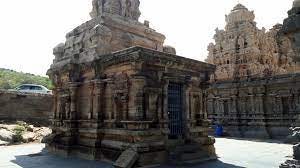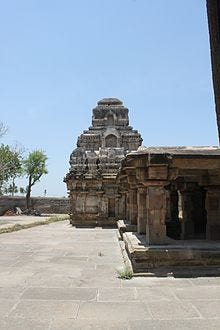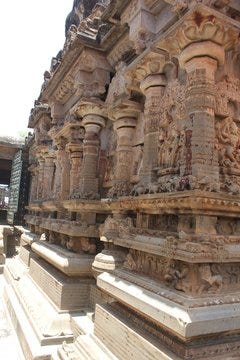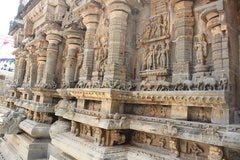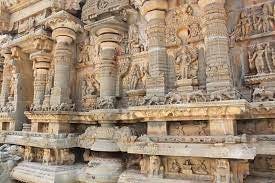Pushpagiri
Pushpagiri Temple complex on the banks of the Penna River houses temples of both Shiva and Vishnu. The chief deities at the Pushpagiri temple complex are Shree Vaidyanatheswara Swamy( Shiva) and Shree Chennakesava Swamy( Vishnu). The temple is known for it's architectural excellence and rich sculpture.
The temple is referred to as Nirvrutti Sangameswara in the Srisaila Khanda of Skand Purana, due to many devotees giving up their lives for Shiva here, and historically it's believed to be dating to 7th Century BCE. As per the Sthala Purana, Garuda while taking the holy Amrutham to liberate his mother Vinutha from bondage, split a drop of it in a small pond by the side of the Penna river, that immediately got miraclous powers of transforming people back to their youth.
When Vishnu ordered Garuda to cover up the pond, the huge rock started floating like a flower on the pond. Vishnu along with Brahma, pressed the rock firmly into the ground with their feet. which gave rise to the name Pushpa Giri( flowery mound). Another story states that Shree Rama worshipped Vaidyanatheswara here, and the flowers used piled up as a large mound here, which gave rise to the name Pushpagiri.
Pushpagiri was first mentioned in Puranas as place visited by Janamajeya after he performed the Sarpa Yaaagam, there is an inscription at the village of Chintalapatturu that states this. Also close to Pushpagiri is the Agastheeswara Swamy temple, where it is believed that Agasthya Maharshi stayed after he crossed the Vindhyas.
Regarded as the Dakshina Dwaram for the Srisailam Temple, Pushpagiri is noted for it's diverse architectural styles that began with the Early Cholas to the Vijayanagara Empire later. Also it's believed three rivers- Penna, Arkavati, Palar originated due to cosmic dance of Shiva at Nandi Hills. While the other two became tributaries of Cauvery, it's believed Penna asked Shiva, in which direction should she flow.
Shiva then let an arrow out from his mighty bow Pinakini, which made a path to the east, also creating the gorge at Gandikota. This is reason why Penna river is also called as Pinakini. The Vaidyanatheswara Swamy, temple in Pushpagiri was built during reign of the Rashtrakuta ruler Krishna Vallabha, who also provided the lands for it.
Saluva Narasimha Deva Raya made multiple grants to the Chennakesava Swamy temple. Later his feudatory Dhuli Basivi Naidu, looked after the temple, as well as protecting the pilgrims from the bandits. Pushpagiri has also been host to multiple traditions, the Vaidyanatheswara Temple has a murthi of Lakulisha here, who is regarded as the precptor of Pashupata, the oldest of the major Shaivaite sects.
Also the Shankara Peetham was one of the patrons of Srisailam temple, which led to the observance of the Pashupata Shaivisim and Shakteya traditions here.
The complex is noted for it's diverse architectural styles in a single area, that go all the way back to the Ikshavakus, as well as inscriptions ranging from that era to those of Pallavas, Cholas,Rashtrakutas, Chalukyas, Kakatiyas, Vijayanagara Empire.
The Vaidyanatheswara Temple here is famous for it's rock cut sculptures. It has the Srichakra in the Kamakshi shrine as soon as one enters from the northern gate, the other famous Shaivaite temple here is that of Indranatha.
The Indranatha temple faces with steps leading all the way from the Penna river, the Gopura is in the South West direction, and the complex has a Mandapam with 12 pillars, richly carved with sculptures.
However its the Chennakesava Temple that stands out with it's magnificient architecture and sculpture. Facing west with a tall Dwajastambham, that faces the Penna, which incidentally changes course here from west to east. he Chennakesava Temple complex has 3 shrines inside, and 2 smaller shrines, separated by a ridge. It has elaborate carvings on all sides, one noticeable aspect is using pot shaped ballasts to support the carvings, a feature of Chola style.
The Chennakesava Temple faces west, has a 10 feet deity, which itself has very elaborate carvings showing the Dasavataras. The complex has another shrine for his consort Rajyalakshmi, while the Gopuram here faces West.
The various carvings and sculptures in Pushpagiri complex are a veritable treasure trove,depicting the Puranas, Ramayana, Mahabharata, battles of the kings.While Chennakesava and Vaidyanatheswara Temples are the most prominent in Pushpagiri, the complex has other temples too of Santāna Malleśwara, Trikūteshwara, Sākśi Malleśwara, Pāthāla Ganapathi.



